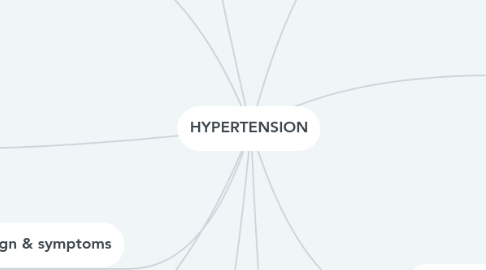HYPERTENSION
作者:Woraprat Theethuan

1. Type
1.1. 1. Primary (essential or idiopathic) hypertension
1.2. 2. Secondary Hypertension
2. Hypertension in Elderly
2.1. • Isolated systolic hypertension (ISH)
2.2. • Lifetime risk of developing hypertension
2.3. • Reasons for increased BP in elderly
3. Mechanism
3.1. Neurogenic control
3.2. Renin-angiotensin system
4. Sign & symptoms
4.1. 1. Primary Hypertension
4.1.1. does not have symptoms other than high blood pressure
4.2. 2. Secondary Hypertension
4.2.1. • Most likely caused by Renal Disorders, symptoms you will see: • Decreased urine formation • Increased sodium and water retention
5. Treatments
5.1. Non-pharmacological treatment
5.2. Pharmacological treatment
6. Rehabitation
6.1. Nutrition and Dietary Supplements
6.2. Exercise Training
7. Definition
7.1. An elevated blood pressure (BP) is defined as a systolic blood pressure (SBP) > 140 mm Hg or diastolic blood pressure (DBP) > 90 mm Hg or both.
8. Classification
8.1. • Normal
8.2. • Prehypertension
8.3. • stage 1 hypertension
8.4. • stage 2 hypertension
9. Complications
9.1. • Peripheral vascular disease • Nephrosclerosis • Retinal damage
10. Causes of hypertension in elderly
10.1. 1. Increased collagen and stiffness of myocardium
10.2. 2. Loss of baroreflex
10.3. 3. Loss of beta I-adrenergic receptors stimulation
10.4. 4. Changing of endothelial cells
10.5. 5. Inefficient renal system
10.6. 6. May have altered drug absorption; delayed metabolism and excretion; becareful when medicating.


